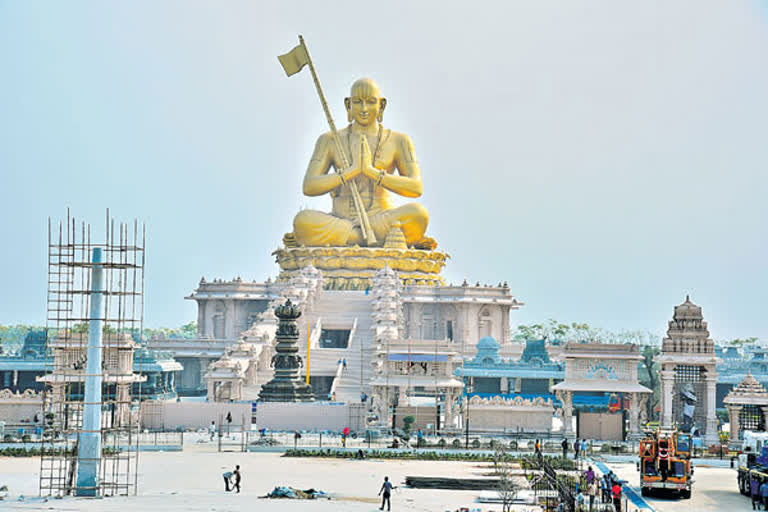Hyderabad: Sri Ramanuja millennium celebrations will be held from February 2 to 14. Who’s who from across the country will attend the two-week festivities. In addition to the President, Prime Minister, Governors and Chief Ministers of various states will grace the ceremony. While the festivities will kick off on February 2, Agni Pratishta will be performed on February 3. On February 5, Prime Minister Modi will unveil the 'Statue of Equality.
In this backdrop, ETV Bharat goes down the memory lane and brings out the life history of Ramanujacharya, who was one of the important proponents of Sri Vaishnavism at a time when society was rife with caste and religion, he preached Vishishtadvaita. Though it has been one thousand years since he had first laid the stone for various social reforms, we can see their impact on society even today.
In fact, he revolted against caste discrimination and involved downtrodden classes in the Vaishnava worship. He reformed existing rituals and made way for people from other castes to participate in religious rites. Ten centuries later, his Vishishtadvaita school of Hindu philosophy continues to be universally valid.
Most of us know that Divya Saketham at Muchintal in the Rangareddy district of Telangana hosts the magnificent Sri Ramanuja’s statue. But, what if one wants to see Ramanuja’s sacred mortal remains? Unknown to many, Sri Ranganathaswamy temple at Srirangam, Tamil Nadu, has preserved the mortal remains of Sri Ramanuja. In fact, this is where Ramanuja attained samadhi.
Ramanujacharya is believed to be the incarnation of Adisesha on whom Lord Vishnu rests. Ramanuja was born in Sriperumbudur village in 1017 CE. By the age of 15, he became proficient in several scriptures. With careful observation and study, he grasped the essence of complex Vedic texts. Furthermore, he presented the knowledge he earned in simplified terms to common people. According to his school of Vishishtadvaita, all human souls can reach the bliss state of God.
Sri Ramanuja certainly holds a special place in devotional Hinduism. Thousand years ago, conflicts between Shaivism and Vaishnavism were commonplace. Social discrimination was prevalent. Downtrodden castes were denied entry into temples. In such times, Ramanuja proposed the revolutionary idea of universal equality. He preached that all people are equal in the eyes of God. He was a great social reformer, who united people in a society that was rife with inequalities.
Besides facilitating temple entry to Dalits, Ramanuja taught them Vedic rituals and made them priests. He even reformed the existing temple system and ensured equal involvement of people from all the sections in temple worship. The Alwar saints appointed by him stood by the same principles. Internationally, out of the 12 Alwars selected to preach Vaishnavism, 11 belonged to non-Brahmin castes. Interestingly, a female Alwar disciple was also a part of the religious group. Ramanuja indeed lived by the principles of caste and gender equality. He was intolerant to inequalities propelled by the caste system. The majority of his disciples were from lower classes and would participate in religious processions. The same tradition continues to this day.
Ramanujacharya proposed the rituals that have to be performed to Lord Balaji, including what offerings to make, and which clothes to be used to adorn the deity. These practices are being continued in the honour of Vaikhasana Shastra. Many of the traditional rituals introduced by Ramanuja are being followed in Tirumala. A king in Tamil Nadu’s Kumbakonam threw an idol of Lord Vishnu into the sea, in an attempt to destroy Vaishnavism. Ramanuja got another deity made, and established it in Tirumala temple.
Sri Ramanuja travelled across the country and restored many temples. He set up management systems and worship rituals as per his belief in equality. He proclaimed that all devotees of Lord Vishnu were Vaishnavas. He even reformed the rituals at Sri Ranganathaswamy temple and introduced important principles of worship in Srirangam, Tirupati and Kanchipuram. He paraphrased the holy texts of the Bhagavad Gita and Brahma Sutras. Ramaunja’s important works are Vedartha Sangraham, Sri Bhashyam, Gita Bhashyam, Sriranga Gadyam and Srivaikuntha Gadyam. He wrote influential texts to propagate the principles of Vishishtadvaita.
Also read: PM, President to attend unveiling of Ramanujacharya statue



